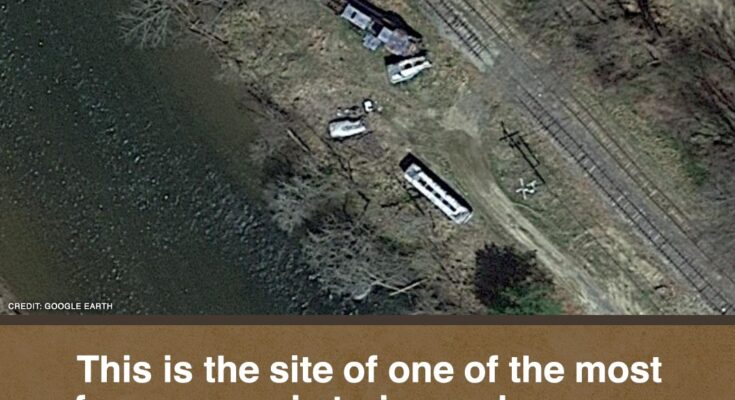More often than not, when you’re watching a movie from the 20th century, you’re seeing a soundstage or a studio backlot. Filmmakers routinely created massive settings for their movies inside enormous soundstages, or reused something from a previous film. It happens often, because filming on-location is often more expensive than recreating the real thing.
Sometimes, however, a soundstage just doesn’t cut it, and filmmakers have created immense sets out in the real world. While most are torn down once filming is complete, others remain standing. Some even become popular tourist attractions, and the most impressive of them can be seen from space! This list highlights some of the more interesting satellite images of old movie sets, thanks to Google Earth.
Hobbiton – Matamata, New Zealand

Photo: Warner Bros. Pictures / Google Earth
Director Peter Jackson’s The Lord of the Rings trilogy did much to improve New Zealand tourism, which has a lot to do with how picturesque the country is. Fans can visit numerous locations from the filming of both the LOTR trilogy and The Hobbit, but one is by far more popular than the rest.
Not only can you spot the Shire from space, but you can also explore it! The Hobbiton Movie Set is situated about two hours from Auckland, and it’s an exceptionally popular tourist attraction. Visitors can stroll around the Shire, eat at several cafes, reserve an evening banquet tour or a second breakfast tour, and other cool stuff.
Jackson’s team chose the site in 1998 during the production of The Fellowship of the Ring, and it’s in an ideal location. Hobbiton was constructed on a 1,250-acre sheep farm, although it only uses about 12 acres. It took nine months to complete (with the help of members of the New Zealand Army) and includes 39 Hobbit Holes, most of which were merely facades. Much of the original site was demolished and removed, but when Jackson returned in 2009 for An Unexpected Journey, he left the set standing.
The ‘Field of Dreams’ Baseball Diamond – Dyersville, IA

Photo: Universal Pictures / Google Earth
Field of Dreams is about protagonist Ray Kinsella, who hears “If you build it, he will come” from his cornfield, so he does the obvious thing and builds a baseball diamond. The whole plot hinges around this construction project, so that’s precisely what the film crew had to do, descending upon two farms outside Dyersville, IA, to create the setting.
The baseball diamond went up on a farm owned by the Lansings, while the left and center fields were built on an adjacent farm owned by the Ameskamps. This was done to ensure the best location possible was used for filming.
When the movie wrapped, the two families erected souvenir stands and began building what would become a new tourist attraction. In 1990, the “Ghost Players” baseball team formed to play on the field and entertain visitors. This brought thousands of people to the site, and the aptly named Field of Dreams settled into its niche of Americana.
Fans can visit the field year-round, tour the home, spend the night in a three-bedroom house built on the property, rent the field for private games, or sit back and watch the Ghost Players put on their own game in what locals call the “Greatest Show on Dirt.”
Viking Village – Höfn, Iceland

Photo: Google Earth
A lot of interest in Viking culture has arisen lately, thanks to TV series like Vikings and feature films such as The Northman. People have long been fascinated with Vikings and their culture, so it’s not surprising that so much media features them. Viking buildings are rather distinctive, so whenever a production needs to set one up for filming, they usually create it from scratch.
Universal Studios put much time and money into recreating a Viking village near the Icelandic fishing village of Höfn (also called Höfn & Hornafjörður). Unfortunately, the movie the studio planned never got underway, but in the mid-2010s, a film called Vikingr (still in development) began shooting there. Another production that set its sights on what is now called Viking Village includes Netflix’s The Witcher: Blood Origin. From space, the locale looks to be in a gorgeous spot – and it is.
You can visit Viking Village and tour the various buildings, making it seem like you’re stepping back in time. While a huge blockbuster film was never shot there, you can see the level of detail put into making it look as authentic as possible. Visitors can also take self-directed driving tours, dine in the cafe, or stay in two nearby inns.
Sweethaven In ‘Popeye’ – Mellieħam, Malta

Photo: Paramount Pictures / Google Earth
Popeye may not be Robin Williams’ best-known film, but that doesn’t mean it didn’t make an impact. The film was shot in Malta, and to make the town of Sweethaven look just right, the filmmakers went a bit overboard, allowing crews to build what amounted to an entire village, and it remains today as a popular tourist attraction aptly called Popeye Village.
The set consisted of 19 buildings and a breakwater around Anchor Bay. It took seven months to construct, and when filming wrapped, the set remained.
If you visit Popeye Village in Malta, it’s much more than a film set. The buildings have been outfitted with accoutrements from the film to firmly establish the Popeye-esque nature of the site. Visitors can also attend various Popeye-related shows, go mini-golfing and swimming, or even hold weddings there.
‘Spaghetti Western’ Town – Almería, Spain

Photo: Produzioni Europee Associate / Google Earth
If you’re a fan of Westerns, you’re likely familiar with the term “Spaghetti Western,” a genre shot in southern Europe – mostly Italy and Spain – instead of in the US. The term also comes from the fact that most of the films’ directors were Italian, including Sergio Leone, Sergio Corbucci, and Tonino Valerii.
A popular Spaghetti Western filming location was Almería, Spain, which provided the backdrop for the Man With No Name Trilogy, all starring Clint Eastwood: A Fistful of Dollars (1964), For a Few Dollars More (1965), and The Good, The Bad and the Ugly (1966).
The city is located in Tabernas, Europe’s only desert, and it isn’t just visible from space; it’s also a popular tourist destination. Long after Western movies put Almería on the map, part of it was transformed into a Mediterranean theme park with a zoological reserve, restaurants, specialty pools, educational activities, and an Old West town that hosts shoot-out shows and can-can dances. There’s even a cinema museum that highlights the movies shot there in the 1960s and ’70s.
Reconstructed Płaszów Labor Camp – Krakow, Poland

Photo: Universal Pictures / Google Earth
Schindler’s List is one of those movies that could have been filmed just about anywhere, but Steven Spielberg likes to go for authenticity. Concentration camps are largely preserved throughout Europe, so they stand as both reminders of the horrors of humanity and as memorials to the deceased. Hence, filming in the actual Płaszów Labor Camp in Poland wasn’t an option.
Instead, the crew built a replica in a nearby quarry – using the original blueprints – just a few hundred feet from the real camp. While it’s possible to visit the movie set, it’s not a preserved site. The locale is mostly overgrown, but you can still see parts of it from space.
Most of the so-called Holocaust tourism in the area is directed to the Jewish Ghetto and the Auschwitz camp, so there wasn’t much interest in preserving a replica of an existing camp that doesn’t see as many visitors.
The Alamo – Alamo Village, Brackettville, TX

Photo: United Artists / Google Earth
The Alamo is one of Texas’s most popular tourist spots, and that’s only partly because it sits within the historic San Antonio Riverwalk. More than 2.5 million people visit the building and grounds each year. It’s also in the middle of a major metropolitan city and has been for decades, so filming there isn’t exactly an option. As a result, the famous mission has been recreated for various films, including John Wayne’s The Alamo, released in 1960.
Alamo Village, which went up in the 1950s in Brackettville, was the very first movie set built in Texas. Over the years, it was used in 72 feature films, six documentaries, six music videos, and 13 commercials. It was later dubbed “Alamo Village Vacationland” and hosted tourists eager for Wild West shows and other activities. The set remained open for years, but Alamo Village, Inc. eventually closed it and issued the following statement in 2010:
Family and management alike wish to thank all those who have contributed their hearts, talents, and hard work to Alamo Village over the past fifty years.
You can still see Alamo Village from space, though it’s not as exciting as watching a Wild West show in the same place they filmed The Alamo.
‘The Fugitive’ Train Crash – Sylva, NC

Photo: Warner Bros. / Google Earth
The 1993 action/crime drama The Fugitive was filmed in many places, but one location is easily the most recognizable and relevant: the train crash. It’s how Dr. Richard Kimble escapes from custody to go on the run and find his wife’s killer, thus clearing his name. The crash is particularly well-shot, considering no CGI helped make it happen. On top of that, the scene was shot in a single take, which is no easy task.
When filming wrapped, the train and the bus it slammed into were left in place in Sylva, NC, near the Jackson County Green Energy Park and visible from the road. The site is approachable on foot with some hiking, but it’s not exactly open to the public for touristy visits. Many film enthusiasts, however, have snuck down to take pictures of what has become a somewhat obscure roadside attraction visible from space.
Jerusalem In ‘Kingdom of Heaven’ – Ouarzazate, Morocco

Photo: 20th Century Fox / Google Earth
Kingdom of Heaven focuses on the events leading up to the Third Crusade, so the film hinges upon the siege of the Kingdom of Jerusalem. A believable castle and its grounds had to be built from the ground up to ensure everything looked authentic, so the filmmakers turned to Atlas Corporation Studios in the city of Ouarzazate, Morocco.
The studio sits on a large plot of land outside the city, and for some 50 years has been the location of numerous films, including Gladiator, Black Hawk Down, Mission: Impossible, and of course, Kingdom of Heaven.
If you tour Atlas Corporation Studios, you’ll have to set aside a good chunk of your visit to see the Kingdom of Heaven set – it’s a separate tour from the main one. And unlike the other tours, it takes up a whole day – it’s that massive! The set covers 12 acres of land with buildings representative of 12th-century Jerusalem, surrounded by 370 acres of undeveloped land that works particularly well for battle scenes.
‘Hunger Games’ District 12 – Henry River Mill Village, NC

Photo: Lionsgate Films / Google Earth
To appropriately portray the squalor in which the denizens of District 12 lived in The Hunger Games, the filmmakers had to find something unique. They could have built everything from the ground up, but instead of going to all that trouble, they opted to use the Henry River Mill Village, which was established in 1905. Its mill burned down in 1977, and only a two-story company store and 20 wood-frame houses remain.
The site was abandoned, so it was just the right level of dilapidation when filming began. After the movie wrapped, the village was designated a historic location in the National Register of Historic Places. This isn’t necessarily related to its use for the movie; it’s more related to the historic nature of the buildings. Regardless, you can visit the village and even book a night in the fully restored house #12. Additionally, guests can take guided tours, Hunger Games-themed tours, or even get married there.



